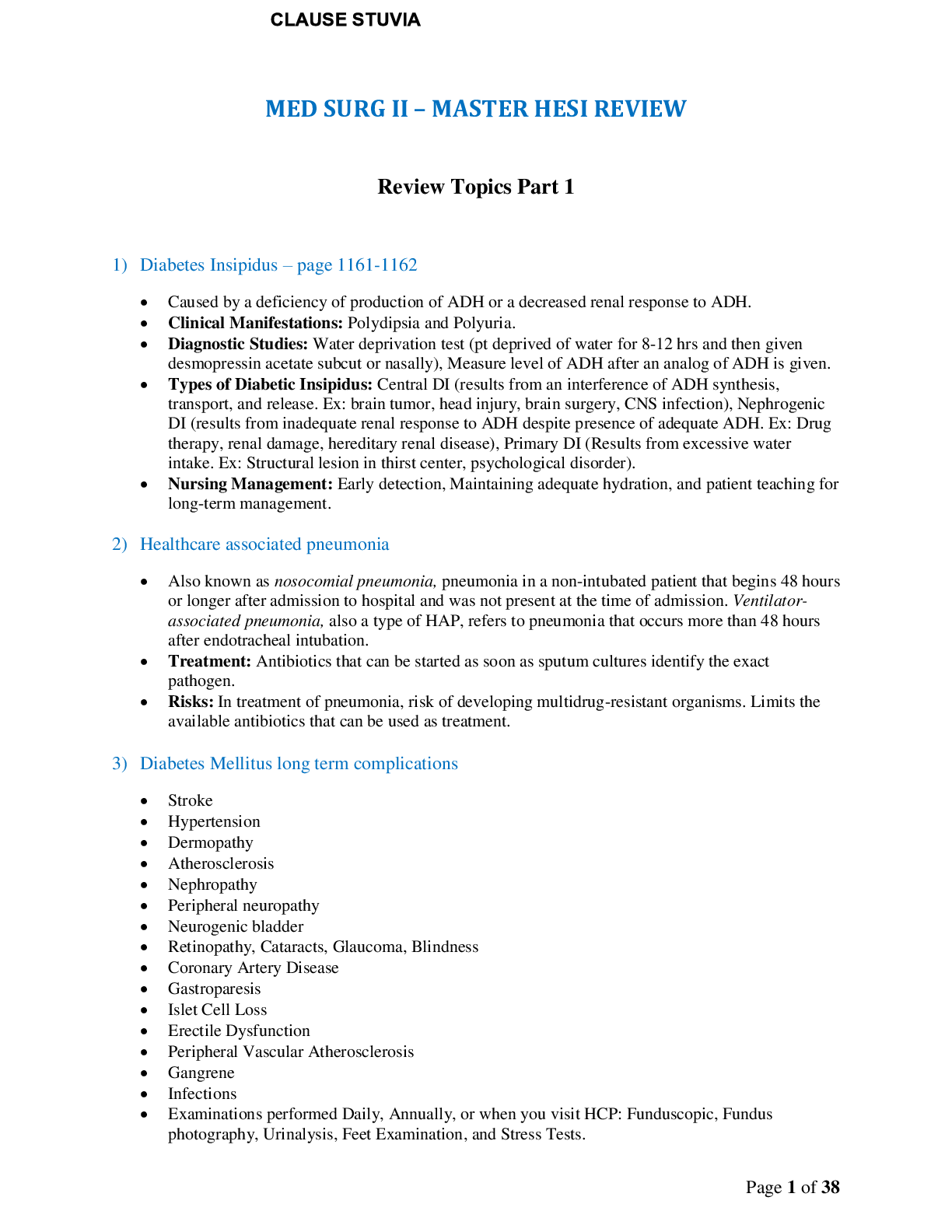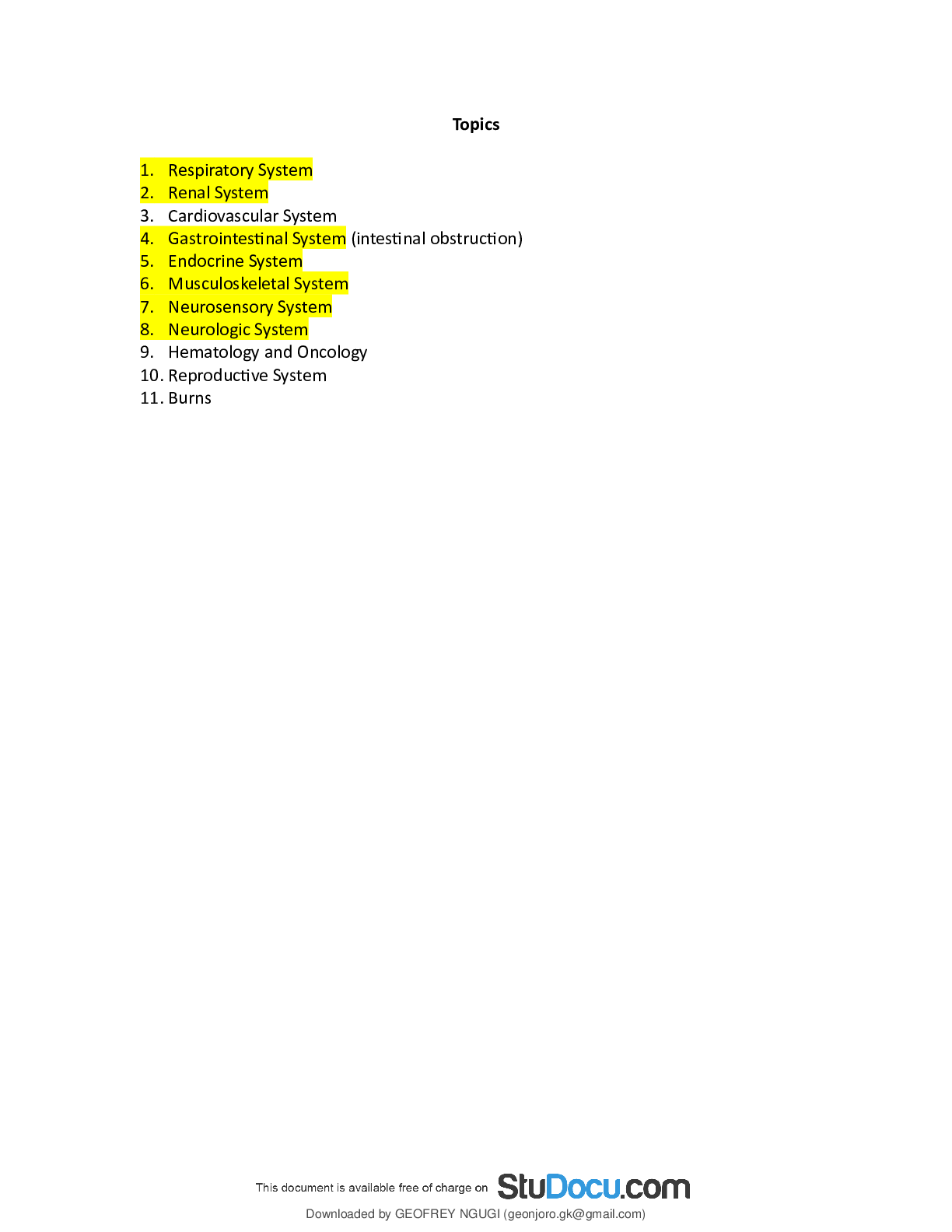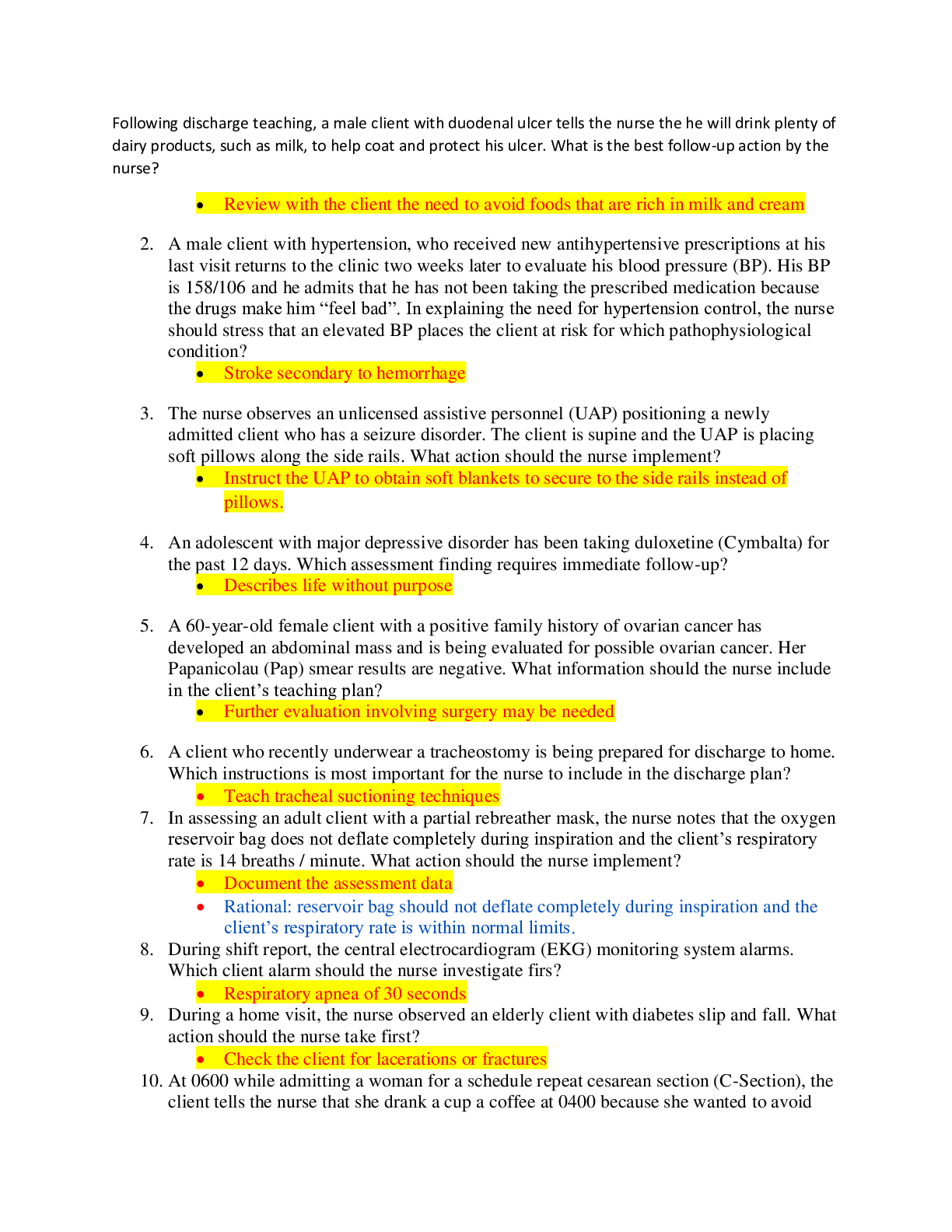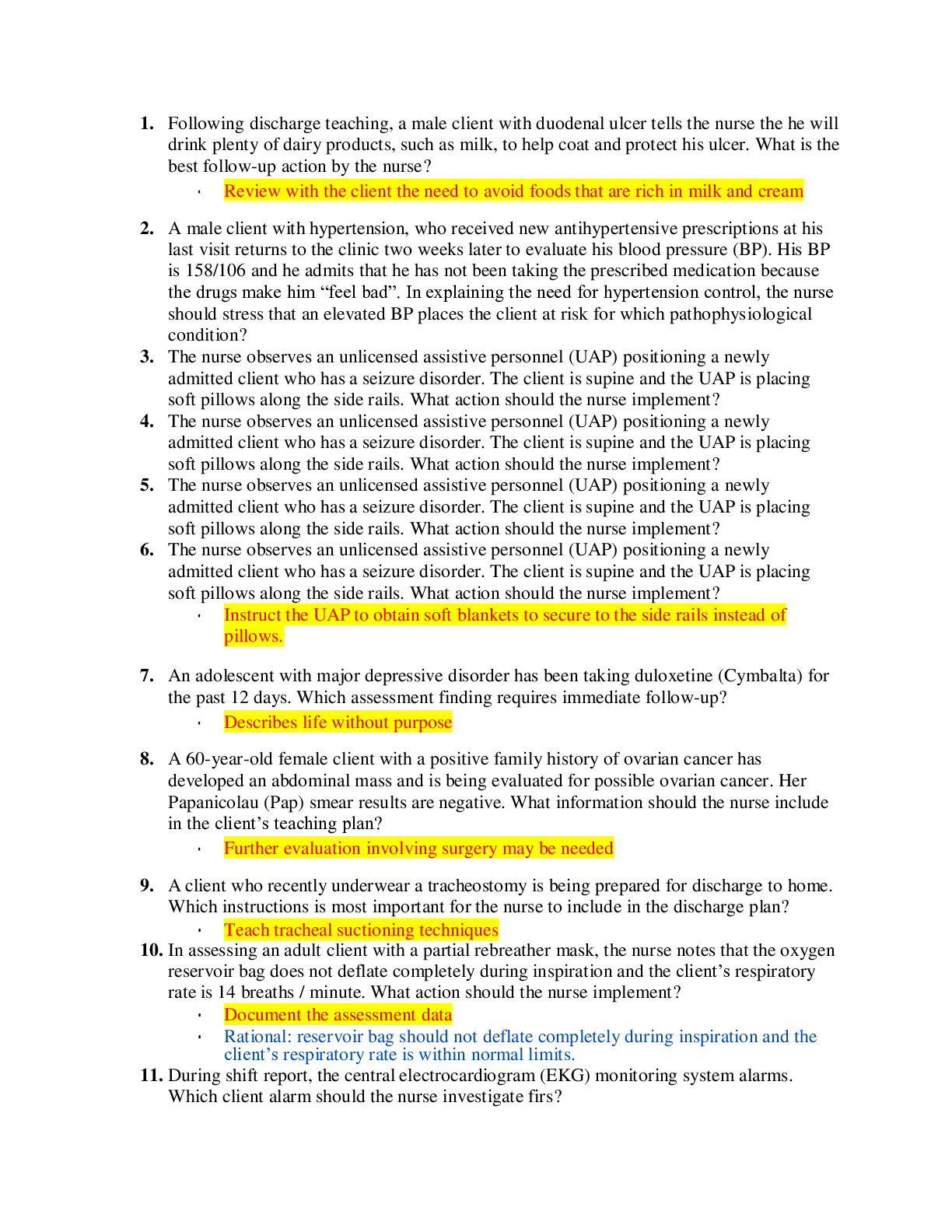Surgery > HESI MED SURG > Med Surg II - MASTER HESI Review Packet (All)
Med Surg II - MASTER HESI Review Packet
Document Content and Description Below
1) Diabetes Insipidus – page 1161-1162 Caused by a deficiency of production of ADH or a decreased renal response to ADH. Clinical Manifestations: Polydipsia and Polyuria. Diagnostic S ... tudies: Water deprivation test (pt deprived of water for 8-12 hrs and then given desmopressin acetate subcut or nasally), Measure level of ADH after an analog of ADH is given. Types of Diabetic Insipidus: Central DI (results from an interference of ADH synthesis, transport, and release. Ex: brain tumor, head injury, brain surgery, CNS infection), Nephrogenic DI (results from inadequate renal response to ADH despite presence of adequate ADH. Ex: Drug therapy, renal damage, hereditary renal disease), Primary DI (Results from excessive water intake. Ex: Structural lesion in thirst center, psychological disorder). Nursing Management: Early detection, Maintaining adequate hydration, and patient teaching for long-term management. 2) Healthcare associated pneumonia Also known as nosocomial pneumonia, pneumonia in a non-intubated patient that begins 48 hours or longer after admission to hospital and was not present at the time of admission. Ventilatorassociated pneumonia, also a type of HAP, refers to pneumonia that occurs more than 48 hours after endotracheal intubation. Treatment: Antibiotics that can be started as soon as sputum cultures identify the exact pathogen. Risks: In treatment of pneumonia, risk of developing multidrug-resistant organisms. Limits the available antibiotics that can be used as treatment. 3) Diabetes Mellitus long term complications Stroke Hypertension Dermopathy Atherosclerosis Nephropathy Peripheral neuropathy Neurogenic bladder Retinopathy, Cataracts, Glaucoma, Blindness Coronary Artery Disease Gastroparesis Islet Cell Loss Erectile Dysfunction Peripheral Vascular Atherosclerosis Gangrene Infections Examinations performed Daily, Annually, or when you visit HCP: Funduscopic, Fundus photography, Urinalysis, Feet Examination, and Stress Tests. CLAUSE STUVIA MED SURG II – MASTER HESI REVIEW Page 2 of 38 4) Renal dosing/ issues with drugs – page 1020 Box 44-3 ANTIBIOTICS OTHER DRUGS OTHER AGENTS Amikacin Captopril Gold Amphotericin B Cimetidine Heavy Metals Bacitracin Cisplatin Cephalosporins Cocaine Gentamicin Cyclosporine Neomycin Ethylene Glycol Polymyxin B Heroin Streptomycin Lithium Sulfamidies Methotrexate Tobramycin Nitrosoureas Vancomycin NSAIDS Phenacetin Quinine Rifampin Salicylates 5) Spinal cord injury – page 1419-1437 Classification: (1) Mechanism of Injury, (2) Level of Injury, (3) Degree of Injury. Clinical Manifestations: Motor and Sensory effects, Respiratory System (decrease in vital capacity volume), Cardiovascular System (bradycardia, peripheral vasodilation, hypotension), Urinary System (urinary dysfunction), Gastrointestinal System (incontinence, impaction, ileus, megacolon, decreased GI secretion) , Integumentary System (skin breakdown, pressure ulcers), Thermoregulation (Adjustment from body temp to room temp), Peripheral Vascular Problems (Pain, VTE, PE) Emergency Management: Table 60-3 Ph. 1425 NURSING ASSESSMENT o Subjective Date: Health History o Objective Data: Poikilothermism (unable to regulate body heat) o Integumentary System: Warm dry skin below level of injury o Respiratory: Injury at C1-3-Apnea, Inability to cough. Injury at C4-Poor Cough, diaphragmatic breathing, hypoventilation. Injury at C5-T6- Decreased respiratory reserve. o Cardiovascular: Injury above T6-Bradycardia, hypertension, absence of vasomotor tone. o Gastrointestinal: Decreased or absent bowel sounds, abdominal distension, constipation, fecal incontinence, fecal impaction. o Urinary: Retention, flaccid bladder, Spasticity with reflex bladder emptying. o Reproductive: Priapism, altered sexual function o Neurologic: Complete-Areflexic, flaccid paralysis, hyperactive deep tendon reflexes, bilaterally positive Babinski test. Incomplete- Mixed loss of voluntary motor activity and sensation. o Musculoskeletal: Muscle atony, Contractures. o Pain: Neuropathic, musculoskeletal, and/or visceral. MED SURG II – MASTER HESI REVIEW Page 3 of 38 6) Blood in stool Melena = black, tarry stools (often foul smelling) caused by digestion of blood in the GI tract. Black appearance is from the presence of iron. Occult bleeding = small amounts of blood in gastric secretions, vomitus, or stools not apparent by appearance. Detectable by guaiac test. Could be indication of an upper GI bleed Hemorrhoids are the most common reason for bleeding with defecation o Focus on pain control and promote wound healing o Sitz bath 1 to 2 days after surgery and continue for 1 to 2 weeks o Teach the pt importance of diet, care of the anal area, symptoms of bleeding complications, and avoidance of constipation and straining 7) CVA (focus on vision issues) Cerebral vascular accident / Stroke Treat as medical emergency Know FAST (Facial drooping, Arm weakness, Speech difficulties, Time) Sudden trouble seeing in one eye should be reported immediately for indication of a CVA Women who experience migraine with aura are at an increased risk for stroke. 8) Acute kidney injury Slight deterioration in function to severe impairment Rise in serum creatinine and/or a reduction in urine output, and sometimes leads to development of azotemia (accumulation of nitrogenous waste products in the blood) Hospitalized patients develop AKI at a high rate and have a high mortality rate Common causes: o Prerenal: Hypovolemia, Decreased Cardiac Output, Decreased Peripheral Vascular Resistance, Decreased Renovascular Blood Flow o Intrarenal: Nephrotoxic injury, Interstitial Nephritis o Postrenal: BPH, bladder cancer, calculi formation, trauma Clinical manifestations: o Urinary changes – oliguria o Hypovolemia o Metabolic Acidosis o Sodium balance o Potassium excess o Hematologic disorders o Waste product accumulation o Neurologic disorders Diagnostic studies: o H&P o Identification of precipitating cause o Serum creatinine and BUN levels o Electrolytes o Urinalysis o Renal Ultrasound o Renal scan o CT scan Primary treatment is to eliminate the cause, manage the signs and symptoms and prevent complications while the kidneys recover MED SURG II – MASTER HESI REVIEW Page 4 of 38 9) Abscess A swollen area within the body tissue, containing an accumulation of pus The body’s immune system sends WBC to fight the infection Painful, swollen lump that is filled with pus S/S = chills, fever, pimples, redness, painful lump, pus, tenderness, swelling, swollen lymph nodes Treatment includes draining the abscess and antibiotics Types mentioned in MedSurg: Anorectal (p. 970), brain (p. 1338), lactational breast (p. 1207), lung (p. 512), peritonsillar (p. 484) 10) Amyotrophic Lateral Sclerosis (lung issues) AKA Lou Gehrig’s Disease A nervous system disease that weakens muscles and impacts physical function. In this disease, nerve cells break down, which reduces functionality in the muscles they supply. The cause is unknown. The main symptom is muscle weakness. Medication and therapy can slow ALS and reduce discomfort, but there's no cure. Muscular: muscle weakness, problems with coordination, stiff muscles, loss of muscle, muscle spasms, or overactive reflexes Whole body: fatigue or feeling faint Speech: difficulty speaking or vocal cord spasm Also common: difficulty swallowing, drooling, lack of restraint, mild cognitive impairment, severe constipation, severe unintentional weight loss, shortness of breath, or difficulty raising the foot Treatment includes: o Therapies o Supportive Care o Medications (glutamate blocker or muscle relaxant) o Surgery o Medical procedure 11) Neutropenic precautions is a blood condition involving low levels of neutrophils, a type of white blood cell. Neutrophils fight infection by destroying harmful germs. Without enough neutrophils, you’re more likely to develop infections. Usually, neutropenia occurs after: chemotherapy, radiation therapy or taking certain medicines. Remember: Gown, Gloves, Mask to protect the patient from catching any foreign bodies that night cause an infection. If the patient leaves the room, they must have a mask on before leaving and it must remain on them at all times while they are outside the room [Show More]
Last updated: 2 years ago
Preview 1 out of 38 pages

Buy this document to get the full access instantly
Instant Download Access after purchase
Buy NowInstant download
We Accept:

Also available in bundle (1)
Click Below to Access Bundle(s)

HESI MED SURG COMBINED EXAM REVIEW MUST STUDY A+ GRADED LATEST REVIEW
Elsevier HESI Med-Surg Review Med Surg II - MASTER HESI Review Packet MED SURG HESI 3
By TESTPASS 2 years ago
$18.5
3
Reviews( 0 )
$12.00
Can't find what you want? Try our AI powered Search
Document information
Connected school, study & course
About the document
Uploaded On
Feb 13, 2023
Number of pages
38
Written in
All
Additional information
This document has been written for:
Uploaded
Feb 13, 2023
Downloads
0
Views
155






 Test Bank.png)



.png)





